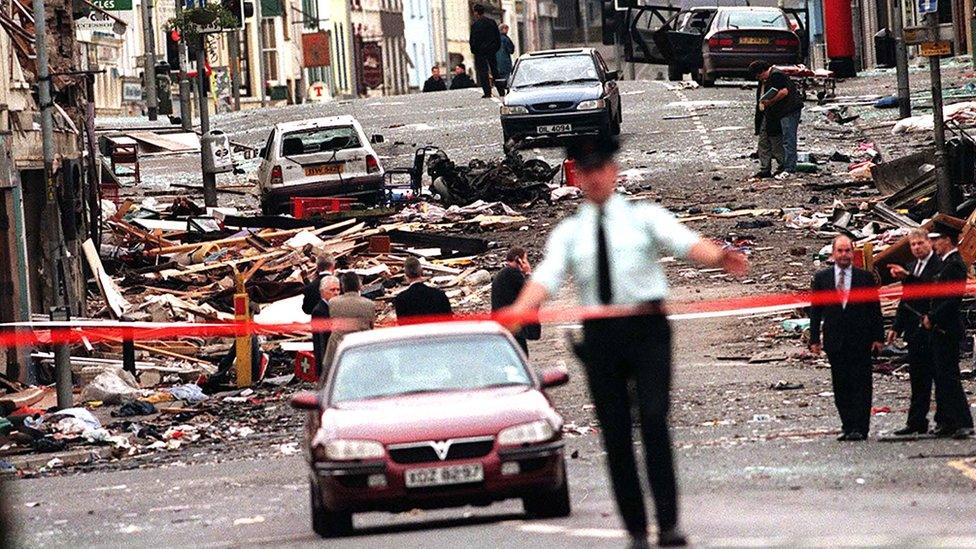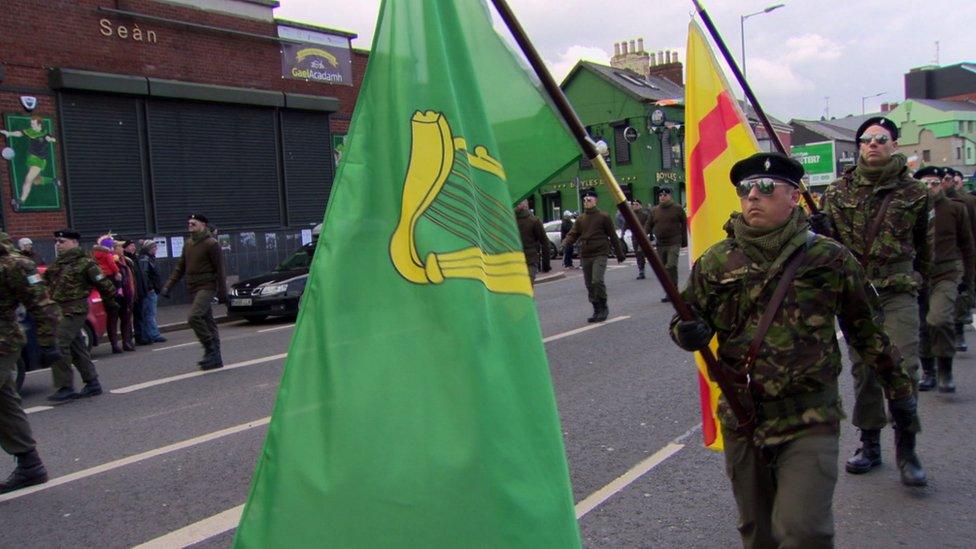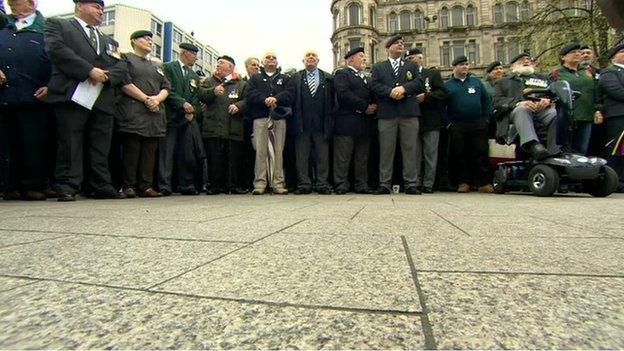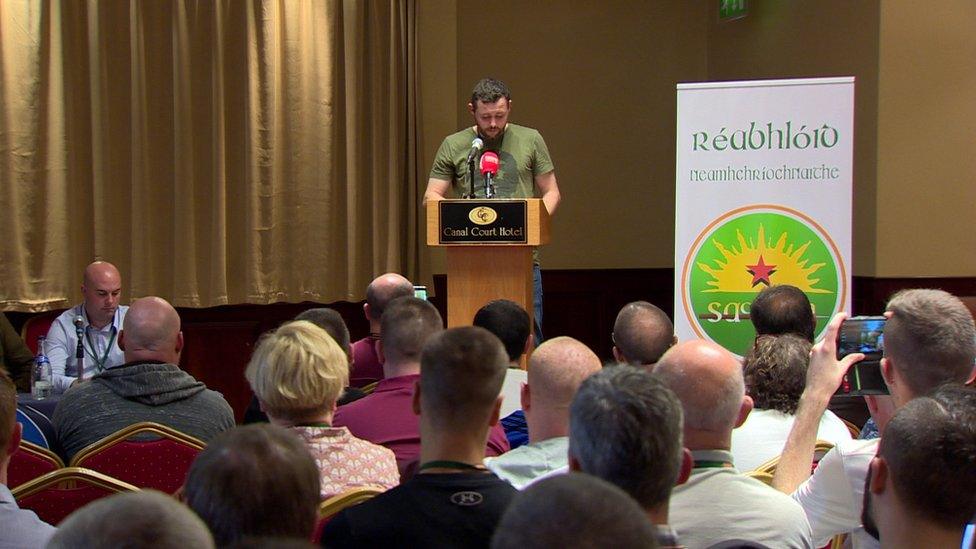New dissidents hoping to exploit Brexit
- Published
Newsnight: Brexit, 'new' dissidents and the Irish border
Veteran BBC journalist Peter Taylor talks to dissident republicans and NI's top policeman about Brexit and what its consequences could mean for Northern Ireland.
I've lost count of the number of Easter commemorations I've filmed in Belfast, marching two miles up the Falls Road to Milltown cemetery where the IRA's dead lie buried.
This year it seemed an all too familiar sight.
Columns of men and women in combat fatigues and dark glasses, marching in military step to the thudding rhythm of black boots hitting the road.
But this march was different.
It was held by dissident republicans under the banner of a relatively new, hard left political party called 'Saoradh' - Irish for Liberation.

Saoradh held its first Ard Fheis in Newry in 2016
Saoradh, pronounced seeroo, was founded in 2016, the centenary of the Easter Rising in Dublin and takes its hard left, anti-imperialist ideology from the revolutionary James Connolly rather than the scholarly Patrick Pearse.
Brexit has returned the question of the Irish border to the centre of Anglo-Irish politics - an issue that had gradually faded after the Good Friday Agreement of 1998.
The dissidents intend to exploit it to the full.
To hundreds of their supporters gathered around Milltown's republican plot for the graveside oration, it's manna from heaven.
As Patrick Carty, one of Saoradh's leaders, told the crowd: "Brexit has the potential to break up the British state… with the inevitable infrastructure of a hard border imminent, this will drive home to the Irish people the partition of our country… and as history teaches us it will inevitably stoke the fires of resistance against British rule in Ireland."
Would you notice if you crossed the Irish border? (Video from 2017)
The question is what form does that resistance take and to what extent is Saoradh involved in it?
Is it the armed resistance of the IRA or the resistance of peaceful protest across a range of issues from poverty to housing and, of course, the border?
Armed resistance now comes from the main dissident group referred to by the police and MI5 as the New IRA.
It's known to the organisation itself and Saoradh simply as 'the IRA', in the belief that it is the true heir to the historic IRA, not the Provisional IRA (PIRA) that finally decommissioned its arsenal in 2005.
To the dissidents, PIRA and Sinn Féin are traitors who have betrayed the cause of uniting Ireland through 'armed struggle', by becoming constitutionalists and entering a devolved, partitionist government at Stormont.

The PSNI chief constable said an attack from dissident republicans on police or prison officers is still "highly likely"
The emergence of the New IRA causes the chief constable of the Police Service of Northern Ireland (PSNI), George Hamilton, great concern.
"The threat they pose is assessed as being severe," he told me.
"An attack is highly likely against police officers and prison officers".
The chief constable points out that the New IRA has carried out about 40 attacks in the six years since it was formed in 2012, a period in which two prison officers and two police officers were killed by dissident republicans.
But the chief constable remains confident that his officers, often acting on intelligence from MI5, the lead intelligence agency in Northern Ireland, "disrupt or stop more attacks than they actually get to carry out".
In 2010, MI5 first published the terrorism threat level for Northern Ireland - it labelled it "severe" and it has remained there since.
"We certainly work very hard both covertly and overtly to make their life difficult [and] to disrupt their activities," the chief constable said.
The interception earlier this month of a viable explosive device and a firearm in Lurgan and a similar device in Strabane in April bears out the chief constable's words.
"The organization is minuscule compared to what the Provisional IRA was," he added.
"They have nowhere near the weapons and explosives available to them."
Paramilitary split
The New IRA has a tortuous and complex pedigree as well as a bloody one.
Its origin goes back to PIRA's extraordinary army convention held on 10 October 1997 in the tiny village of Falcarragh in County Donegal, six months before the Good Friday Agreement.
The convention, a gathering of PIRA leaders and rank and file IRA volunteers from all over Ireland, had been called to ratify the leadership's recommendation, advocated by Gerry Adams and Martin McGuinness, that PIRA and Sinn Féin should sign up to the principles of non-violence drawn up by Senator George Mitchell, the chairman of the all-party talks that were to lead to the Good Friday Agreement.

On 10 April 1998 Martin McGuinness and Gerry Adams signed the Good Friday Agreement
The historic motion to accept the Mitchell Principles was passed which meant that the IRA had voted itself out of business.
But the decision was not unanimous.
A small but powerful group of experienced IRA men walked out in protest, along with the individual alleged to be the IRA's quarter master general who knew where many of the weapons from the IRA's vast arsenal were stashed away - on both sides of the border.
Much of it, from AK47s to Semtex explosives, had come from Libya in the late 1980s.
It's believed that some of these armaments, despite decommissioning, ended up in the hands of the New IRA, despite, I understand, threats made on the doorstep at the time by senior IRA men to dissident leaders that they should make sure that no weapons remained in their hands "if they wanted to carry on breathing".
This nucleus of dissidents re-formed as the Real IRA, claiming legitimacy from history.

Twenty nine people, including a woman pregnant with twins, were killed when a car bomb exploded in Omagh in August 1998
Less than a year after its formation, the Real IRA bombed the market town of Omagh, massacring 29 people, barely four months after the Good Friday Agreement. The dissidents put down a bloody marker.
In the years that followed, other dissident groups emerged (the Continuity IRA had already been around since a previous split in the IRA in 1986) but none eclipsed the Real IRA that remained the cutting edge of violent republican resistance.
IRA veterans
Finally in 2016 those groups that had not already disbanded, came together under the banner of the New IRA with, for the first time, a single combined leadership.
It was this that most worried the security and intelligence services as it consisted of some of the hard-core IRA veterans involved in the Falcarragh split.
Saoradh vehemently denies it is the political wing of the New IRA.
I interviewed a prominent Saoradh dissident, Paul Duffy who, from the outset, wanted to make his personal position and Saoradh's position, clear.
"I'm not a member of any armed group. I'm not involved in any armed group. Saoradh as a political party is not involved in armed actions."

Paul Duffy speaking at an Easter Rising commemoration parade in 2017
Nothing could be clearer than that. But what is their attitude towards armed actions carried out by others?
"If we're talking about resistance to partition and resistance to British occupation, there are armed groups out there who are involved in actions against the occupying forces," said Mr Duffy.
That was as far as he would go. But does he support those armed actions?
A direct answer was never on the cards. He said that if he was to offer any analysis or argument around the issue of support for groups such as the IRA, he would risk prosecution. This would have been under the 2006 Terrorism Act, ending up with a possible five years in prison.
I assumed that he would support such actions - "assume away, Peter," he said, giving me a look that warned that enough was enough.
'Significant overlap'
The chief constable has no such inhibitions about nailing Saoradh's colours to the New IRA mast.
"Saoradh is the political voice of the New IRA. I think there is significant overlap between the leadership of both the New IRA and Saoradh," said Mr Hamilton.
"They are not quite one and the same. There are a number of people who are very senior in the New IRA who are also senior in the leadership of Saoradh [that] would be our assessment."

Men and women dressed in combat fatigues march along the Falls Road in west Belfast
Saoradh dismisses the chief constable's assessment.
As warned at Saoradh's Easter commemoration, Brexit is England's difficulty and Ireland's opportunity.
The chief constable has little doubt what that would mean in the unlikely event of there being a hard border and, should that be the outcome, he fears for his officers' security.
"A hard border, one assumes, would bring with it physical infrastructure that would become a target," he said.
"Anything that presented physical infrastructure would, in our assessment, become a target for violent dissident republicans."
And that means the New IRA.
'Go away'
Such a scenario, were it to happen, might conceivably trigger a return to the dark days of the past.
That, however, is unlikely to happen for two reasons.
A hard border with physical infrastructure is highly unlikely, given that all parties are determined to avoid it and the dissidents' Achilles Heel remains: a significant lack of support, as Gerry Adams told me with a passion.
"There is no community support for a return to conflict anywhere," said the former Sinn Féin president.
"They [the New IRA] may have the ability to carry individual actions but all thinking republicans are committed to peaceful, democratic means. The IRA is gone."
I asked what he would say to some of the dissident leaders who were once his former comrades.
"Go away," he said.
To which Paul Duffy replied: "We have no intention of going home, Gerry."
Watch the full Newsnight report here at 22:30
- Published18 April 2017

- Published14 April 2017

- Published24 September 2016
